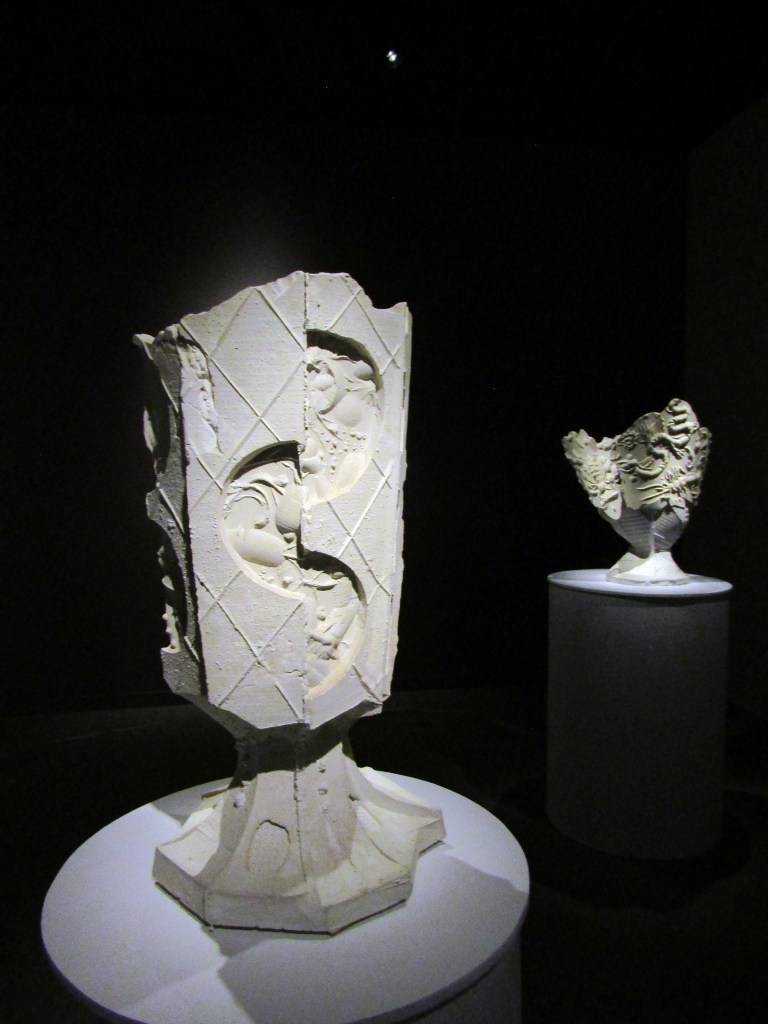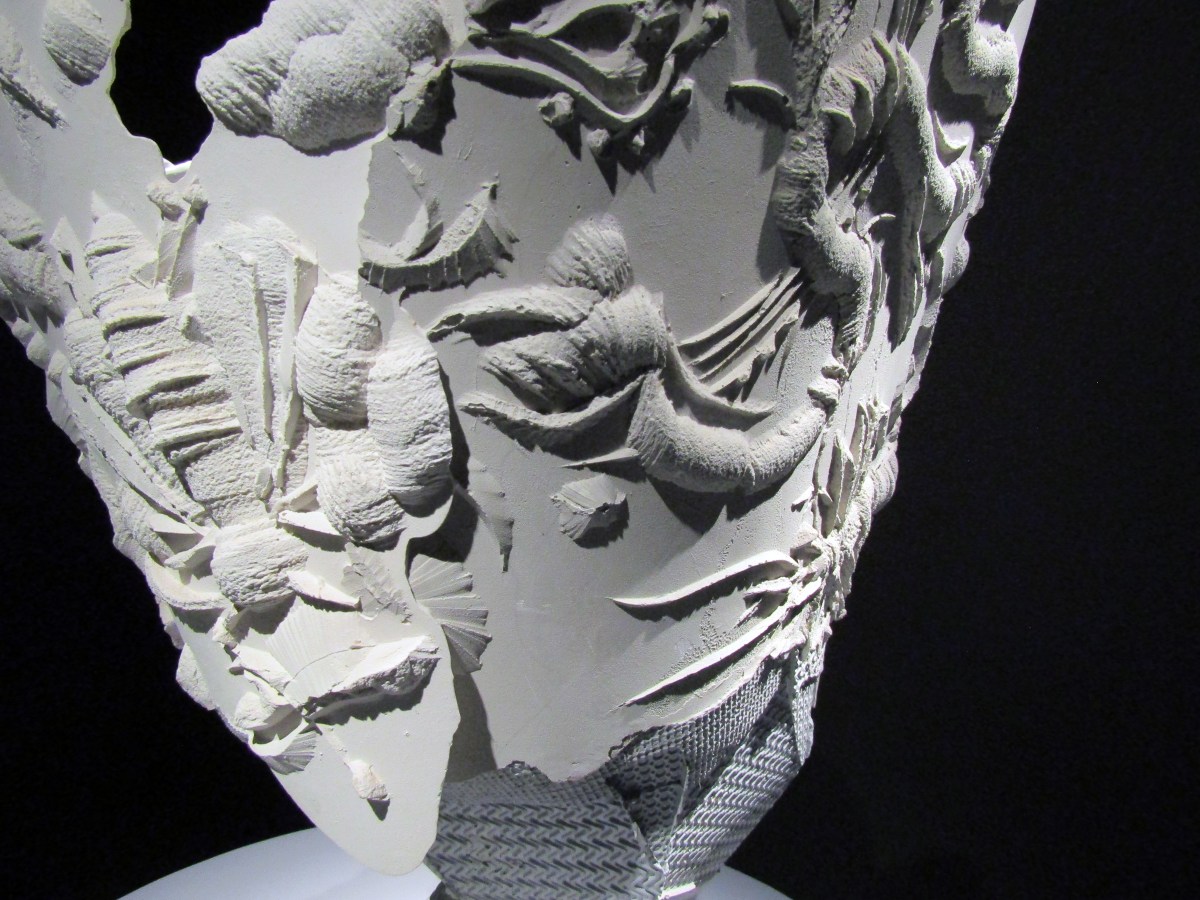In Speculative Archaeology, Brisbane-based artist of Nigerian and English heritage, Bruce Reynolds, has created a testament to the past splendour of human endeavours and invites audiences to partake in imagining an even finer future.
The main gallery is populated by sculptures, both relief and freestanding, which feature identifiable elements in intriguing combinations. The forms of Archaic Vessel (2014) and Seljuk Vessel (2022), for instance, are ceremoniously layered like wedding cakes or inverted towers of Babel. The latter, which greets visitors as they enter the main gallery, references the architecture of the Central Asian Seljuk Empire of the 11th century. Its multiple surfaces, each carved and cast separately, pay homage to the friezes of Hatra. In recognition of their destruction at the hands of Isis in the mid-2010s, Reynolds has fractured and reconfigured a series of classical figures.
A number of the other vessels, such as Language Vessel #2 (2022) at the far end of the gallery space, may be compared in shape to the seminal perspective study of a chalice drawn by Gabinetto dei Disegni in the 15th century. In aesthetics, it draws together abstract patterns reminiscent of modern domestic décor and fossil-like figurative representations of crustaceans.
Arthropods were the first variety of animal to make ‘landfall’ and their remnants are a key component of gypsum. The recurrent motifs were cast from carved moulds, a technique employed by proto-Renaissance artist Giotto di Bondone. He cast gypsum plaster in woodblocks to create low relief components in his fresco paintings. By contrast, Reynolds uses polyethylene foam sheets to carve the moulds for his surfaces.
In between di Bondone and dei Disegni, Leon Battista Alberti also laid the foundation for linear perspective and modelling, both of which resonate in 20th century 3D modelling. In De Pictura, published in 1450, Alberti defined modelling as a combination of subtractive and additive sculpting, with all objects consisting of a series of surfaces. These complex classical sentiments are celebrated by Reynolds in this post-digital era, with his predilection for analogue methods adding to the anachronic quality of his artwork.
Where the vessels are joined in horizontal layers, an association may be made with the rhetoric of 3D printing, a digital technology that evolved from the ancient coiling of clay. When the vessels are joined vertically, semblance may be found in the relationship between material cutting and pasting using knives or scissors and the digital desktop publishing that this process informed during the late 1990s.
These ‘quasi-functional’ objects triumph in emphasising that all artefacts may serve as vessels for the human condition. They also appear to satisfy the two distinct definitions of ‘artefacts’, the first being products of human workmanship with cultural significance, and the second as objects resulting from scientific investigation. Notably, the post-digital age has been heralded for redressing a rift between the arts and sciences that began during the mid-Renaissance.

A mark of Reynold’s virtuoso is his exercise of restraint. His application of colour is seductively selective, leaving much white space for audiences to simply enjoy form. The carved and cast elements exhibit his technical brilliance, yet there is a rustic simplicity in some of the seams. Among the joining processes employed by the artist is the pouring of ‘modified’ gypsum and allowing it to seep and set within the crevices. These literal rough edges provide entry points for audiences, an accessibility with respect to an ‘I can do this too’ aesthetic but, more importantly, they also signal an incompleteness. The artist leaves space for viewers to insert their own imaginations.
Genius is seldom hurried, and this series is a culmination of a relentless interrogation of pattern Reynolds began more than three decades ago through vibrant vintage linoleum collages. The material is synonymous with the wanton destruction of the colonial, federation and art deco, buildings of the Bjelke-Petersen Era, and the subsequent efforts of residents to restore their inner city Queenslanders in the 1990s. The impetus for his present approach, employing casting and carving, was a residency he undertook in 2013 at the British School at Rome.
Between the time the earliest sculpture in Speculative Archeology was made, 2014, and now, a seminal treatise on creativity was published: The Runaway Species, which was co-authored by US neuroscientist David Eagleman and Anthony Brandt. The role creatives play in defining the future through bending, breaking and blending the past is a central theme. The sentiment is epitomised by this journey Reynolds has instigated for his audience, inviting them to revel in the achievements of humanity through his ‘archaeology’ and collectively speculate upon its future.
Speculative Archaeology is open at Artisan in Brisbane until 4 March 2023.





